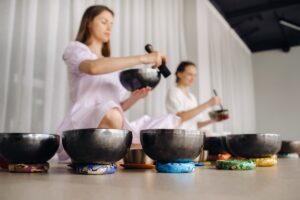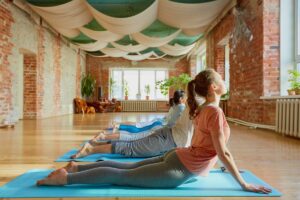Want to be healthy, balanced, and tranquil throughout your senior years? Just try walking meditation. Indeed, walking and meditation together may improve your mind, body, and spirit.
I’ve experienced walking meditation’s power. The most surprising thing in my case was that meditation doesn’t need as much silence as I thought. In fact, walking meditation is ideal for individuals who have problems sitting still or prefer being outside and moving. Whether it’s the sound of birds chirping, the traffic noise, or just having people around, the setting can make a huge difference. This aspect is particularly important for retirees who might feel lonely at home or lack many friends to spend quality time with.
What is walking meditation? Well, by walking slowly and mindfully, you concentrate on your body, breath, and surroundings. It’s a simple activity that can be done anywhere, even in your backyard.
So what are you waiting for? Put on your comfiest clothes, get out, and try walking meditation in a quiet spot you love.

Reduces stress and anxiety
Stress and anxiety are the most common symptom as people adjust to retirement. Simple as it may seem, walking can calm the mind and body, thus helping you stay present and reduce stress and anxiety.
Further, this habit can keep you physically active and healthy – an essential perk for retirees. It can allow you to explore new places and socialize. Walking can reduce stress, improve mood, and keep you mentally sharp even after 60.
Of course, this practice may be harder for those with physical limitations or chronic health conditions. In these cases, walks may need to be intensified or shortened, or you can pick another type of meditation, like yoga.
It boosts concentration
Walking meditation improves concentration by focusing on the present. This practice enhances concentration by increasing brain blood flow and nourishing brain cells. Walking may also increase brain endorphins, which boosts mood and reduce stress.
Physical activity may increase “flow,” or deep focus and concentration, much like other meditation techniques do. This can help retirees stay mentally sharp and engaged.
Lastly, walking allows us to experience new sights and socialize, which is vital for a happy retirement!
It boosts well-being
Walking meditation increases well-being and reduces depression and negative emotions. Of course, this depends on your physical condition, the environment you’re in, and your mood.
Walking can be relaxing, especially in a pleasant environment or with a friend. Some walk to clear their minds and relieve stress, while others walk to think and reflect. Either way, this type of meditation can be easily practiced by anyone.
Improves physical health
Walking is an excellent exercise for seniors. It is a low-impact exercise that can be tailored to different skill levels and has many health benefits as follows:
- improved balance, coordination, and bone density;
- chronic diseases like heart disease, diabetes, and osteoporosis;
- improved cognition, memory, and mood.
Read also: 6 Ways Meditation Boosts Your Health in Retirement
It boosts creativity
Walking appears to improve creativity and problem-solving. This practice may increase brain endorphins, which improve mood and reduce stress. Relaxed and positive people may be more open to new ideas and creativity.
Walking lets us experience new sights, sounds, and experiences. This stimulates the brain, which can spark creativity and problem-solving skills.
It’s important to note that walking and creativity are complex and influenced by various factors, including the person’s personality, physical and mental state, and environment. However, it’s definitely worth a try!
Improves sleep
Walking and mindfulness can improve sleep.
Walking has many sleep benefits, including for retirees. Regular exercise, including walking, may improve sleep quality and reduce the risk of sleep disorders.
Physical activity may improve sleep by reducing stress and mood. Walking increases brain endorphins, which improve mood and reduce stress. This improves sleep.
Walking may also help regulate the body’s natural sleep-wake cycle in retirement. Physical activity during the day can help us fall asleep and stay asleep at night.
It’s important to note that the relationship between walking and sleep is complex and influenced by many factors, including an individual’s personality, sleep habits, and health and well-being. Walking can help retirees sleep better.
Reduces chronic pain
Walking and mindfulness reduce stress hormones and chronic pain by relaxing the body. Therefore, walking meditation involves focusing on the feet and breathing while walking. This method can reduce stress, improve well-being, and help chronic pain sufferers.
Mindfulness practices like walking meditation may reduce chronic pain sensitivity and improve pain management. Mindfulness can increase present-moment awareness and reduce rumination on negative thoughts and emotions, which can increase pain perception. What’s more, physical activity reduces inflammation, improves sleep, and lowers stress and anxiety, which may help chronic pain sufferers.
It boosts memory and cognition
According to recent studies, walking meditation may improve cognitive function in older adults. Mindfulness may protect older adults from cognitive decline by improving attention, memory, and decision-making.
Meanwhile, walking improves cognitive health by:
- increasing brain blood flow, which improves cognitive function and reduces cognitive decline;
- improving memory: Walking increases brain-derived neurotrophic factor (BDNF), which helps brain cells grow and survive;
- reducing the risk of cognitive decline and Alzheimer’s disease;
- boosting creativity and problem-solving, which is good for mental health.
It increases energy
Walking boosts energy and well-being. Mindfulness practices may reduce fatigue and improve well-being in people with chronic diseases like cancer and multiple sclerosis.
Practicing mindfulness may also increase brain endorphins, which improve mood and reduce stress. All of these things combined help you gain energy and feel ready to start the day!

Where Can You Practice Walking Meditation?
As a retiree, the best locations for walking meditation are those in your area. Here are a few ideas that might help:
- Parks and natural reservations: Walking meditation in peaceful, natural settings can help you relax and focus.
- Neighborhoods: Walk meditation can be done in your neighborhood or other peaceful places.
- Gyms and fitness centers: Many have indoor walking tracks for walking meditation.
- Gardens and botanical centers: These are peaceful places for walking meditation in warmer weather.
- Beaches and lakes: The sound of waves crashing or water lapping can relax and focus on walking meditation.
Your preferences and resources will determine where to practice walking meditation. Find a quiet place and practice mindfulness regularly.
Your Takeaway
To conclude, walking meditation may help retirees in many ways. This simple practice reduces tension, improves balance and coordination, and makes you feel more present and conscious.
I’ve seen firsthand how walking meditation can change your life. It’s a simple but powerful technique that’s kept me calm and focused in retirement. So why not give it a shot? Choose a quiet place, wear your walking shoes, and start a healthier, happier retirement.
Remember, retirement is a time for self-care and simple pleasures. If you’re already into this habit, drop a comment below and share your top tips with our community!









